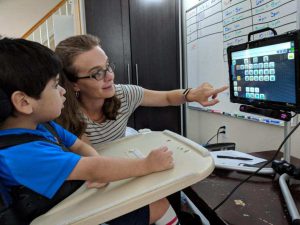 A, As. Ases. Dog. dogs. Doges. Is. ises. Iseses.
A, As. Ases. Dog. dogs. Doges. Is. ises. Iseses.
Joey grins at me as he explores the newly discovered -s button on his device. It’s fun to be able to suddenly add ‘s’ to your words, and he’s enjoyed seeing just how many ‘s’s he can add to a word. At first I felt put out by his distracted activity with the ‘s’ button, but then I remembered that if Joey is going to learn how to make words plural, he is going to have to know how to use the +s button. So explore away. Sillyeseseseses
The most difficult part of supporting Joey’s speech development for me is helping him – as a five year old – understand correct grammar. Parts of speech still feel fairly abstract to teach to young children, and I tend to be more interested in his interactive exchanges and his academic knowledge. Yet supporting him in his understanding of speech that sounds typical will help him better communicate with his world.
For most of us, we learned to make items plural in our speech by listening to our parents and then copying their speech. If we made a mistake – “Mommy, I want ten cookie,” our mom would correct us, we’d copy her, and then we’d get our cookies (or be told no, ten cookies is too much).
If Joey wants to make a word plural, he has to hit a whole separate button after he selects the singular version of the word. It’s another teaching point – and another button to explore and test out. Right now, he’s enjoying testing it out, and I’m letting him play with it and see how it goes. He particularly likes making silly words – adding ‘s’ as many times to a word as he can to watch the word grow.
Another grammatical aspect I have difficulty helping Joey understand is when we use ‘ing’ on some verbs, and not on others. The problem here is that the picture of the verb is only on one of the buttons – sleep. Sleeps, sleeping, and slept are all represented with a bucket in different positions. Joey does not believe me when I tell him that selecting the spilling bucket next to the picture of someone sleeping sounds better in a sentence than the picture of sleep itself. “He is sleep,” he insists, regardless of my prompting for “he is sleeping. From a picture and device perspective, it makes sense. He doesn’t want to talk about a bucket – he wants to talk about sleeping.
I realize that to support Joey I need to take time to support his understanding of grammar and parts of speech more than I would a typically-developing kindergartener. I’m looking for books that let us explore making words plural, and when we can make sentences like “He is running.” It’s also important to remember that while Joey’s sentence structure may be off right now, it doesn’t reflect a decreased ability in communicating – just that learning to speak on a device requires additional learning steps.


